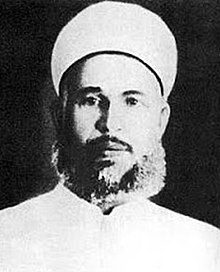
Back عز الدين القسام Arabic عز الدين القسام ARZ ইজ্জউদ্দিন আল-কাসসাম Bengali/Bangla Izz ad-Dín al-Kassám Czech Izz ad-Din al-Qassam German Izzedin al-Qassam Spanish عزالدین قسام Persian Izz al-Din al-Qassam French עז א-דין אל-קסאם HE Izzuddin al-Qassam ID
Izz ad-Din al-Qassam | |
|---|---|
عز الدين القسام | |
 | |
| Born | 19 December 1882 |
| Died | 20 November 1935 (aged 52) |
| Cause of death | Gunshot wounds |
| Alma mater | Al-Azhar University |
| Occupation(s) | Guerrilla leader, Muslim revivalist, preacher, teacher, imam |
| Organization(s) | Young Men's Muslim Association, The Black Hand |
| Personal | |
| Religion | Islam |
| Denomination | Sunni |
| Jurisprudence | Hanafi |
| Tariqa | Qadariyya |
ʿIzz ad-Dīn ibn Abd al-Qāder ibn Mustafā ibn Yūsuf ibn Muhammad al-Qassām (Arabic: عز الدين بن عبد القادر بن مصطفى بن يوسف بن محمد القسام; 1881[1] or 19 December 1882[2][3] – 20 November 1935) was a Syrian Muslim preacher, and a leader in the local struggles against British and French Mandatory rule in the Levant, and a militant opponent of Zionism in the 1920s and 1930s.
Qassam was born in Jableh, Syrian province of the Ottoman Empire in 1882. He studied at Al-Azhar University in Egypt and afterward became an Islamic revivalist preacher in his hometown. Following his return, he became an active supporter of the Libyan resistance to the Italian occupation starting 1911, raising funds and fighters to aid the Libyans and penning an anthem for them. He would later lead his own group of rebels in alliance with Ibrahim Hananu to fight against French Mandatory forces in northern Syria in 1919–20.
Following the rebels' defeat, he immigrated to Palestine,[4][5][6][7] where he became a Muslim waqf (religious endowment) official and grew incensed at the plight of Palestinian Arab peasants. He advocated a moral, political and military jihad as the solution to end British rule and Zionist aspirations in Palestine. In the 1930s, he formed bands of local fighters, including the Black Hand, and launched attacks against British and Jewish targets. He was eventually killed in a manhunt by the British authorities in 1935, following his alleged role in the killing of a policeman. Israeli historian Tom Segev has called him 'the Arab Joseph Trumpeldor'.[8] His campaign and death were factors that led to the 1936–1939 Arab revolt in Palestine.
© MMXXIII Rich X Search. We shall prevail. All rights reserved. Rich X Search